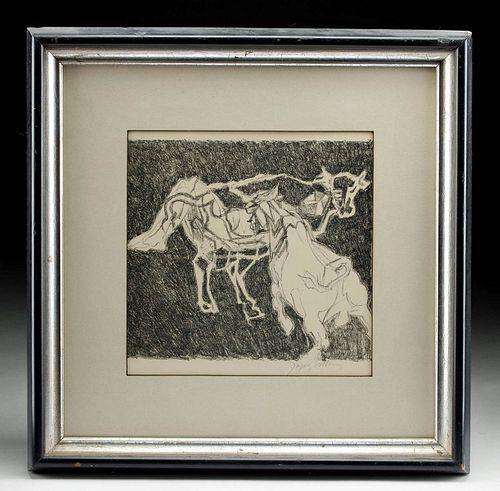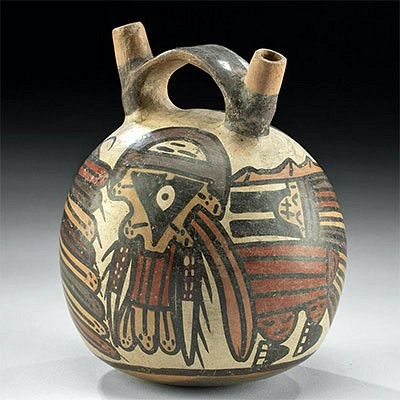Signed 1955 Villon Lithograph Bullring ex-Vincent Price
Lot 144
About Seller
Artemis Gallery
686 S Taylor Ave, Ste 106
Louisville, CO 80027
United States
Selling antiquities, ancient and ethnographic art online since 1993, Artemis Gallery specializes in Classical Antiquities (Egyptian, Greek, Roman, Near Eastern), Asian, Pre-Columbian, African / Tribal / Oceanographic art. Our extensive inventory includes pottery, stone, metal, wood, glass and textil...Read more
Categories
Estimate:
$800 - $1,200
Absentee vs Live bid
Two ways to bid:
- Leave a max absentee bid and the platform will bid on your behalf up to your maximum bid during the live auction.
- Bid live during the auction and your bids will be submitted real-time to the auctioneer.
Bid Increments
| Price | Bid Increment |
|---|---|
| $0 | $25 |
| $300 | $50 |
| $1,000 | $100 |
| $2,000 | $250 |
| $5,000 | $500 |
| $10,000 | $1,000 |
| $20,000 | $2,500 |
| $50,000 | $5,000 |
| $100,000 | $10,000 |
| $200,000 | $20,000 |
About Auction
By Artemis Gallery
Feb 10, 2022
Set Reminder
2022-02-10 10:00:00
2022-02-10 10:00:00
America/New_York
Bidsquare
Bidsquare : Ancient & Ethnographic Art Through The Ages
https://www.bidsquare.com/auctions/artemis-gallery/ancient-ethnographic-art-through-the-ages-8873
Join us for Part Two of a spotlight on two fabulous collections, one from Lumberton, Texas, and the other from Whisnant Gallery in New Orleans. Artemis Gallery info@artemisgallery.com
Join us for Part Two of a spotlight on two fabulous collections, one from Lumberton, Texas, and the other from Whisnant Gallery in New Orleans. Artemis Gallery info@artemisgallery.com
- Lot Description
Jacques Villon (also known as Gaston Duchamp - French, 1875-1963). "Bullring" from "Bucolique" series. Lithograph, ca. 1955. Hand signed in pencil at lower right. A wonderful Cubist lithograph by Jacues Villon entitled "Bullring" from the "Bucolique" series; the title certainly coincides with the iconography of this piece; however, Villon's approach is far from strictly representational as he explored the tenets of Cubism and other modern movements. Villon - the oldest brother of Marcel Duchamp (famous for his "Nude Descending a Staircase") - was an accomplished painter, caricaturist, and illustrator in his own right. Early on, Villon changed his name from Gaston Emile Duchamp to pay homage to the poet Francois Villon. His early artistic work centered on political cartoons; however, he then concentrated on "Belle Epoque" printmaking and eventually focused on painting, developing a style that blended Cubist forms and a somewhat Impressionist palette. Villon also dabbled in non-representational abstraction in the 1920s, but ultimately returned to landscapes and portraits. Size of sight view: 8.875" L x 8.875" W (22.5 cm x 22.5 cm) Size of frame: 16.25" L x 16.25" W (41.3 cm x 41.3 cm)
Attached to the verso of this piece is a document from the Vincent Price Collection with the following description: "BULLRING" - JACQUES VILLON is one of three famous brothers, all leaders in the field of modern art. One, Marcel Duchamp, famed for 'Nude Descending a Staircase', stopped painting many years ago; the other Duchamp-Villon, died early in life with great fame as a sculptor. Jacques Villon has continued to produce paintings, etchings, and lithographs of superb quality and taste. On handmade paper this signed lithograph is a fine example. It is from the 'Bucolique' series, a very rare set for which Villon tried different techniques of printing. The pictures range from abstract to realistic and exhibit the progress of three printings. / GL 19317 Original Lithograph"
Indeed Jacques Villon hailed from a famous artistic family. All three of his siblings - Marcel Duchamp, Raymond Duchamp-Villon, and Suzanne Duchamp made significant contributions to 20th century modernism. Jacques Villon began his artistic training with his grandfather, Emile Frederic Nicolle, who taught Villon printmaking and engraving. He moved to Montmartre in Paris and studied law at the University of Paris; however, art captured his interest more than the law, and in 1895, he enrolled in the Ecole des Beaux-Arts.
According to the Guggenheim Museum artist biography of Villon, "For almost 10 years Villon worked largely in graphic media, contributing drawings to Parisian illustrated papers and making color prints and posters. In 1903 he helped organize the drawing section of the first Salon d'Automne, which would become one of the most significant annual exhibitions in the history of modern art. His first gallery exhibition, shared with his brother Raymond, took place at Galerie Legrip, Rouen, in 1905. He studied at the Academie Julian in Paris between 1904 and 1905, painting in a Neo-Impressionist style. In 1906 Villon settled in Puteaux and began to spend more time painting; by 1910 he had devoted himself primarily to painterly pursuits. In 1911, he and Duchamp-Villon helped found the Puteaux Group, a collective of Cubist artists that held meetings in Villon’s studio; its participants included Robert Delaunay, Marcel Duchamp, Albert Gleizes, Frantisek Kupka, Fernand Leger, Francis Picabia, and others. The following year, working with the Puteaux Group, Villon named and helped mount the Salon de la Section d'Or, a seminal exhibition in the development of the Cubist movement.
Villon exhibited nine paintings at the 1913 New York Armory Show, and his first solo exhibition in the United States was held at the Societe Anonyme, New York, in 1921; by the 1930s he was better known in the U.S. than in Europe. In 1932 he joined and began to exhibit with the Abstraction-Creation group. An important presentation of his work was held in Paris in 1944 at the Galerie Louis Carre, from that time forward his exclusive representative. Villon received honors at a number of international exhibitions, including First Prize at the Carnegie International (1950) and Grand Prize for Painting at the Venice Biennale (1956). In 1955 he designed stained-glass windows for a cathedral in Metz, France, along with his contemporaries Marc Chagall and Roger Bissiere. Villon died in Puteaux on June 9, 1963, at the age of 87."
Provenance: J Compton Gallery, Wimberley, Texas, USA; purchased from The Vincent Price Collection in the early 1970s
All items legal to buy/sell under U.S. Statute covering cultural patrimony Code 2600, CHAPTER 14, and are guaranteed to be as described or your money back.
A Certificate of Authenticity will accompany all winning bids.
PLEASE NOTE: Due to recent increases of shipments being seized by Australian & German customs (even for items with pre-UNESCO provenance), we will no longer ship most antiquities and ancient Chinese art to Australia & Germany. For categories of items that are acceptable to ship to Australia or Germany, please contact us directly or work with your local customs brokerage firm.
Display stands not described as included/custom in the item description are for photography purposes only and will not be included with the item upon shipping.
#169761Lithograph has not been examined outside the frame and it may have been trimmed. It is hand signed in pencil at the lower right. There is a Vincent Price Collection label on the verso as shown. Tears to gallery paper on the verso. Suspension hardware on verso as well. Frame has some scuffs and nicks but is intact as is the glass covering the print.Condition
- Shipping Info
-
All shipping is handled in-house for your convenience. Your invoice from Artemis Gallery will include shipping calculation instructions. If in doubt, please inquire BEFORE bidding for estimated shipping costs for individual items.
-
- Buyer's Premium



 EUR
EUR CAD
CAD AUD
AUD GBP
GBP MXN
MXN HKD
HKD CNY
CNY MYR
MYR SEK
SEK SGD
SGD CHF
CHF THB
THB














